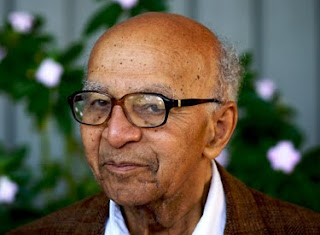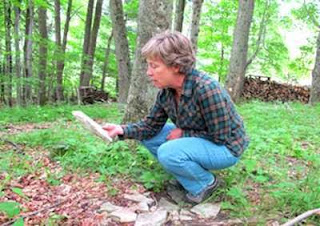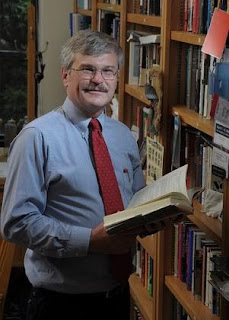BERKELEY — David Harold Blackwell (April 24, 1919 – July 8, 2010), an eminent statistician at the University of California, Berkeley, who was the first black admitted to the National Academy of Sciences, died Thursday, July 8, of natural causes at Alta Bates Medical Center in Berkeley. He was 91.
Blackwell joined the UC Berkeley faculty in 1954 and was the first tenured black professor in campus history. He later chaired the Department of Statistics, one of the world's top centers for mathematical statistics, and served as president in 1955 of the Institute of Mathematical Statistics, an international professional and scholarly society.
A mathematician as well as a statistician, Blackwell contributed to many fields, including probability theory, game theory and information theory. In an interview for the book "Mathematical People: Profiles and Interviews" (1985), he referred to himself as "sort of a dilettante," and said that he chose problems because he was interested in understanding them, no matter what the field of mathematics or statistics.

Statistician David Harold Blackwell was the first tenured black professor at UC Berkeley. | "He had this great talent for making things appear simple. He liked elegance and simplicity. That is the ultimate best thing in mathematics, if you have an insight that something seemingly complicated is really simple, but simple after the fact," said Blackwell's colleague Peter Bickel, a UC Berkeley professor of statistics who has known him since 1960. "Blackwell was a wonderful man and, given the trials and tribulations of his life, a very optimistic person." |
According to Bickel, Blackwell was known for his independent invention of dynamic programming, which is used today in finance and in various areas of science, including genome analysis. He also is known for the renewal theorem, used today in areas of engineering, and for independently developing the Rao-Blackwell Theorem, a fundamental concept in modern statistics.
"He went from one area to another, and he'd write a fundamental paper in each," said Thomas Ferguson, professor emeritus of statistics at UCLA and coauthor with James MacQueen of a 1996 collection of papers in Blackwell's honor. "He would come into a field that had been well-studied and find something really new that was remarkable; that was his forte."
Teaching was Blackwell's other passion.
"He never introduced himself as a professor, he always called himself a teacher," said his son, Hugo Blackwell of Berkeley.
David Blackwell, in explaining why he liked to teach mathematics, once said that "in transmitting it, you appreciate its beauty all over again." The American Mathematical Association and the Mathematical Association of America filmed Blackwell and a small group of other mathematicians giving lectures on various topics accessible to undergraduate students and distributed the films to colleges across the country. The film about Blackwell was titled "Guessing at Random."
During his career, he also participated in United Nations conferences on educational development in Africa, and was selected by the Mathematical Association of America to visit 30 colleges and give 120 lectures throughout the southern U.S. from 1959-60 to enhance mathematical education in undergraduate colleges, many of them historically black.
According to Blackwell's colleague David Brillinger, a UC Berkeley professor of statistics, Blackwell was a major reason Brillinger joined the department in 1970.
"Blackwell made a difference by being a member of many communities; a tremendous role model for the black community, but also interested in the anti-war movement and an advocate for fairness," he said.
In the early '70s, for example, Blackwell brought students to campus in a program for disadvantaged students. As a teacher, he "stripped things to their elements, often saying, 'Look for the simplest solution,'" Brillinger added. "He did much of his teaching by talking about picking balls from boxes."
Early years
Blackwell was born in Centralia, a small town in southern Illinois, on April 24, 1919, as the oldest child of Grover Blackwell, a railway worker, and Mabel Blackwell, who raised the family's four children. Expecting to become an elementary school teacher, David Blackwell entered the University of Illinois at Urbana-Champaign in 1935 at the age of 16, at a time when there were no black professors. After graduating with a B.A. in mathematics in 1938, he set his sights higher and continued at the University of Illinois to earn his M.A. in math in 1939 and eventually his Ph.D. in math in 1941, at the age of 22.
After graduating, Blackwell was appointed a postdoctoral fellow at the Institute for Advanced Study in Princeton, N.J., one of the top research institutes in the nation that included Albert Einstein and John von Neumann among its fellows. Blackwell left after a year, however, because of objections to allowing a black to be an honorary Princeton University faculty member, an honor typically accorded institute fellows.
He subsequently applied to 104 black colleges, assuming, he once said, that the doors were closed to blacks at non-black institutions. After a one-year stint as a statistician in the U.S. Office of Price Administration, originally set up to control prices and rents during World War II, he took an instructorship at Southern University in Baton Rouge, La., and at Clark College in Atlanta, Ga., before joining the faculty of Howard University in 1944. By 1947, he had become a full professor and head of the mathematics department, a position he held until 1954.
While at Howard, Blackwell became interested in statistics after hearing a lecture by Abe Girshick, and the two collaborated for many years. Blackwell developed an interest in the theory of games during three summers, between 1948 and 1950, at RAND Corporation. There, he studied games of timing, as when two duelists approach one other with a loaded pistol, a type of problem that resonated with researchers during the Cold War. He became a leading expert in the area. He coauthored with Girshick the book "Theory of Games and Statistical Decisions," in 1954.
Even before Blackwell moved to Howard, Jerzy Neyman, the leading statistician at the time at UC Berkeley, had courted Blackwell to come to the campus, but had run into objections about his race. After World War II, however, the atmosphere throughout the country had improved, and Neyman was able to convince the mathematics department to hire Blackwell. Blackwell arrived in 1954 as a visiting professor and joined the statistics department as a full professor when the department split off from the mathematics department in 1955. He succeeded Neyman as chair between 1957 and 1961 and served as assistant dean of the College of Letters and Science between 1964 and 1968,
'Totally dedicated'
Although Blackwell retired in 1988, he continued to visit the department until recently, talking with colleagues about statistical ideas, according to his son Hugo.
"He was totally dedicated to his field, and always thought that it's not what you have, but what you think, that is important," he said.
Brillinger added that David Blackwell loved track and field and often went to the national championships even when they were the other side of the country.
In addition to his membership in the National Academy of Sciences, Blackwell also was a fellow of the American Academy of Arts and Sciences, the American Association for the Advancement of Science, the Institute of Mathematical Statistics, the American Mathematical Society and the American Philosophical Society and was an honorary fellow of the Royal Statistical Society.
He also served as president of the international Bernoulli Society for Mathematical Statistics and Probability, and as vice president of the American Statistical Association, the International Statistical Institute, and the American Mathematical Society. In 1979, Blackwell won the John von Neumann Theory Prize from the Operations Research Society of America and the Institute of Management Sciences.
Blackwell mentored 65 Ph.D. students, wrote two books and published more than 80 papers during his career. He held 12 honorary degrees, including from Harvard, Yale, Carnegie Mellon and Howard universities and from the National University of Lesotho.
Blackwell is survived by four of his eight children: Hugo of Berkeley; Ann Blackwell and Vera Gleason of Oakland; and Sarah Hunt of Houston, Texas. He was preceded in death by his wife, Ann Madison Blackwell, who died in 2006 after 62 years of marriage; and children Julia Madison Blackwell, David Harold Blackwell Jr., Grover Johnson Blackwell and Ruth Blackwell Herch.
A funeral is tentatively scheduled for July 31, while a UC Berkeley memorial service is planned for the fall.
UC Berkeley By Robert Sanders, Media Relations.































